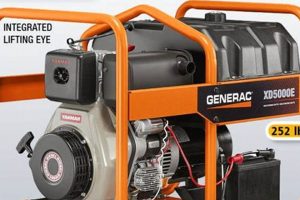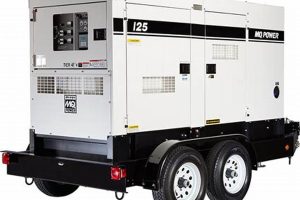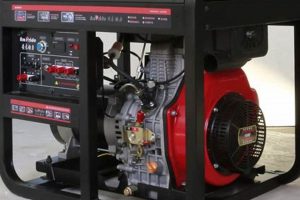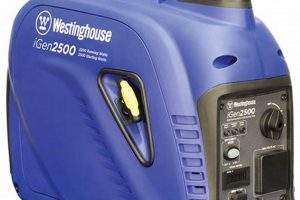Compact, independent power sources fueled by diesel provide electricity in locations lacking grid access or during outages. These units range in size and output, serving diverse needs from powering small appliances to supporting entire job sites or residences. A common example includes powering construction tools in remote areas or providing backup electricity to homes during severe weather.
The ability to generate electricity autonomously makes these devices invaluable for disaster relief, remote operations, and temporary power needs. Their robust design and reliance on a readily available fuel offer reliable and consistent power generation in demanding conditions. The development of more efficient and quieter engines has expanded their applicability in recent decades, making them a preferred choice for a wide range of situations.
This article will further explore the selection, operation, and maintenance of such power sources, covering topics ranging from choosing the right size unit to ensuring safe and efficient performance. Subsequent sections delve into specific applications and address common concerns, providing readers with a comprehensive understanding of these versatile machines.
Operating Tips for Independent Diesel Power Generation
Safe and efficient operation of independent diesel power sources requires careful consideration of several factors. These guidelines ensure optimal performance and prolong the lifespan of the equipment.
Tip 1: Proper Placement: Position units outdoors in well-ventilated areas away from flammable materials. Adequate ventilation is crucial for safe exhaust dispersal and preventing overheating.
Tip 2: Grounding: Always ground the unit to prevent electrical shock. Consult local electrical codes for proper grounding procedures.
Tip 3: Fuel Management: Use clean, fresh diesel fuel and maintain appropriate fuel levels. Avoid overfilling and inspect fuel lines regularly for leaks or damage.
Tip 4: Load Management: Avoid overloading the unit. Calculate the total power requirements of connected devices and ensure they are within the generator’s capacity. Gradual load application can prevent sudden power surges.
Tip 5: Regular Maintenance: Adhere to the manufacturer’s recommended maintenance schedule, including oil changes, filter replacements, and general inspections. Regular maintenance prevents costly repairs and ensures optimal performance.
Tip 6: Cool-Down Period: Allow the engine to cool down before refueling or performing maintenance. Hot engine components can cause burns or ignite fuel.
Tip 7: Weather Protection: When operating in inclement weather, consider using a weatherproof enclosure to protect the unit from rain, snow, or excessive humidity.
Adherence to these operating guidelines ensures safe, reliable power generation and extends the operational lifespan of the equipment. Consistent maintenance and careful operation contribute significantly to maximizing the return on investment.
By understanding these crucial operating tips, users can ensure reliable power generation and contribute to a safer operational environment. This knowledge translates to improved performance and a longer lifespan for these valuable power sources. The following section will conclude the discussion and provide additional resources for further learning.
1. Portability
Portability is a defining characteristic of these generators, directly influencing their suitability for various applications. This feature enables convenient transport and deployment in locations where permanent power sources are unavailable or impractical. Understanding the nuances of portability is crucial for selecting the appropriate unit for specific needs.
- Physical Dimensions and Weight
The size and weight of a unit directly impact its portability. Smaller, lighter units are easily maneuvered by a single person, while larger units may require specialized equipment or multiple personnel for transport. For example, a compact, lightweight unit is ideal for camping or tailgating, while a larger unit might be necessary for construction sites or emergency power supply to larger buildings. The physical dimensions influence storage and transportation logistics.
- Wheel Kits and Handles
Many portable generators incorporate features like wheel kits and integrated handles to facilitate movement. Larger units typically include heavy-duty wheels and robust frames for traversing uneven terrain. The presence and design of these features significantly affect the ease of transport, especially over longer distances or challenging terrain. A rugged wheel kit allows movement across a construction site, while a retractable handle simplifies storage in a vehicle.
- Frame Design and Construction
The frame design contributes to both portability and durability. Robust frames protect the generator components during transport and operation, ensuring longevity and reliable performance in demanding environments. A reinforced frame withstands the rigors of frequent transport and rough handling common in construction or industrial applications, extending the unit’s lifespan.
- Placement Flexibility
Portability allows for versatile placement, enabling users to position the generator in optimal locations for power distribution. This flexibility is critical in scenarios like disaster relief or remote operations where power infrastructure is limited or nonexistent. Positioning a generator near the required power outlets minimizes cable runs and reduces power loss.
The portability of these generators is a critical factor influencing their suitability for a wide range of applications. Careful consideration of size, weight, and transport features is essential for selecting the appropriate unit for specific power needs and logistical constraints. The interplay of these elements determines the overall practicality and effectiveness of portable power generation in diverse scenarios.
2. Fuel Efficiency
Fuel efficiency represents a critical factor influencing the operational cost and practicality of portable diesel generators. Optimized fuel consumption reduces expenses and minimizes environmental impact, making it a primary consideration for both individual and commercial users. Understanding the factors affecting fuel efficiency is crucial for maximizing the return on investment and ensuring sustainable operation.
- Engine Design and Technology
Modern diesel engines incorporate advanced technologies like direct injection and turbocharging to enhance fuel efficiency. These innovations optimize combustion processes, extracting maximum energy from each unit of fuel. A high-efficiency engine translates to lower operating costs and extended run times on a single tank, crucial for remote operations or emergency power supply.
- Load Management and Sizing
Operating the generator at its optimal load range significantly influences fuel efficiency. Overloading or underloading the unit can lead to inefficient fuel consumption. Matching the generator’s output to the power demands minimizes waste and ensures efficient operation. For instance, powering a small refrigerator with an oversized generator results in unnecessary fuel consumption, while attempting to power heavy machinery with an undersized unit leads to strain and reduced efficiency.
- Maintenance and Operating Practices
Regular maintenance, including air filter replacements and fuel system cleaning, contributes to optimal fuel efficiency. Proper operating practices, such as avoiding extended idling periods, also play a significant role. Neglecting maintenance can lead to increased fuel consumption and reduced engine lifespan. A well-maintained engine operates at peak efficiency, maximizing fuel economy and reducing emissions.
- Fuel Quality and Storage
Using clean, high-quality diesel fuel and adhering to proper fuel storage practices further contribute to fuel efficiency. Contaminated or degraded fuel can negatively impact engine performance and increase fuel consumption. Storing fuel in approved containers and following recommended storage guidelines prevents fuel degradation and maintains optimal engine performance.
Fuel efficiency directly impacts the operational cost and environmental footprint of portable diesel generators. Careful consideration of engine technology, load management, maintenance practices, and fuel quality ensures optimal fuel consumption, maximizing the generator’s economic and environmental benefits. Understanding these factors empowers users to make informed decisions and operate their equipment responsibly.
3. Power Output
Power output, measured in watts or kilowatts, represents a critical specification of portable diesel generators, directly determining their capacity to operate electrical devices. Understanding power output requirements is fundamental for selecting a generator capable of meeting specific power demands. This parameter influences the types and number of devices a generator can power simultaneously, ranging from small appliances to heavy-duty equipment. For instance, a generator with a power output of 2,000 watts might suffice for powering essential household appliances during a power outage, while a construction site operating power tools would necessitate a significantly higher output, potentially exceeding 10,000 watts. The consequences of inadequate power output include overloaded circuits, potential equipment damage, and insufficient power supply, highlighting the importance of accurate power output assessment.
Matching the generator’s power output to the anticipated load is crucial for efficient and safe operation. Calculating the combined wattage of all intended devices provides a baseline for determining the minimum required generator output. A safety margin is typically recommended to accommodate potential surges or fluctuations in power demand. Practical applications vary widely: a small camping generator might power lights and a small refrigerator, while a larger unit might support life-saving medical equipment in a field hospital or power tools during disaster relief efforts. Oversizing the generator unnecessarily increases fuel consumption and operating costs, whereas undersizing risks equipment damage and operational disruptions.
Careful consideration of power output ensures appropriate generator selection for intended applications. Accurate assessment of power needs, coupled with an understanding of generator specifications, leads to efficient and reliable power generation. This understanding enables informed decisions, preventing operational issues and maximizing the generator’s utility in diverse contexts. Selecting the correct power output is essential for optimizing performance and ensuring safe, reliable operation across a range of applications, from emergency home power supply to powering remote work sites.
4. Noise Levels
Noise levels represent a significant consideration when selecting and operating portable diesel generators. Excessive noise can disrupt surrounding environments, impacting residential areas, workplaces, and recreational activities. Understanding the factors influencing noise production and available mitigation strategies is crucial for responsible and considerate operation. Noise levels are typically measured in decibels (dB), and regulations often dictate permissible noise limits in specific areas. Excessively loud generators can lead to noise complaints, fines, and strained community relations, underscoring the importance of noise management.
- Engine Design and Construction
The engine’s internal components and construction significantly influence noise generation. Modern engines often incorporate design features aimed at minimizing noise output. For example, advanced fuel injection systems and precision-engineered components contribute to quieter operation compared to older engine designs. The engine’s construction, including the materials used and the overall design, plays a critical role in determining noise levels. Direct injection systems, for instance, generally produce less noise than indirect injection systems.
- Muffler and Exhaust Systems
The muffler and exhaust system play a crucial role in attenuating noise produced by the engine’s combustion processes. Effective muffler designs incorporate chambers and baffles to reduce noise emissions. Regular maintenance and inspection of the exhaust system are essential for ensuring optimal noise reduction. A damaged or poorly maintained muffler can significantly increase noise levels. High-performance mufflers specifically designed for generator applications offer superior noise suppression, minimizing environmental impact.
- Enclosure Design and Soundproofing
Some portable diesel generators feature enclosures designed to minimize noise emissions. These enclosures incorporate sound-absorbing materials and strategically designed airflow paths to reduce noise transmission. The effectiveness of soundproofing varies depending on the enclosure’s design and construction. Critical applications, such as in residential areas or near hospitals, often necessitate generators with sound-attenuated enclosures to minimize disturbance. Properly designed enclosures can significantly reduce noise pollution, making generators suitable for noise-sensitive environments.
- Operating Speed and Load
The generator’s operating speed and load influence noise output. Higher speeds and heavier loads generally result in increased noise levels. Operating the generator at the optimal load range and avoiding overloading contributes to quieter operation. For instance, a generator operating at full load will typically produce more noise than one operating at half load. Matching the generator’s output to the power demand minimizes both noise and fuel consumption.
Noise levels are a crucial factor impacting the suitability of portable diesel generators for various applications. Understanding the factors contributing to noise production, including engine design, muffler systems, enclosure design, and operating conditions, enables informed decision-making. Mitigation strategies, such as selecting generators with advanced noise reduction features and adhering to proper operating practices, minimize noise pollution and ensure responsible generator usage in diverse environments. Careful consideration of noise levels contributes to positive community relations and minimizes disruption in noise-sensitive areas.
5. Maintenance
Maintenance constitutes a critical aspect of owning and operating a portable diesel generator, directly impacting its lifespan, performance, and reliability. A comprehensive maintenance program ensures consistent power delivery, minimizes downtime, and prevents costly repairs. Neglecting routine maintenance can lead to premature engine wear, reduced fuel efficiency, and potentially catastrophic failures. Regular maintenance intervals, as specified by the manufacturer, should be strictly adhered to, ensuring optimal generator performance and longevity. For instance, neglecting regular oil changes can result in increased engine wear and potential seizure, while failing to clean or replace air filters restricts airflow, impacting combustion efficiency and power output. The connection between maintenance and performance is undeniable, with diligent upkeep contributing significantly to reliable operation and extended service life.
Several key maintenance tasks contribute to the overall health and longevity of portable diesel generators. Regular oil changes, typically performed after a specific number of operating hours, ensure proper lubrication and prevent excessive engine wear. Air filter replacement maintains adequate airflow to the engine, optimizing combustion and power output. Fuel filter changes prevent contaminants from entering the fuel system, protecting sensitive engine components. Inspecting and cleaning spark plugs ensures efficient ignition and optimal fuel combustion. Battery maintenance, including checking electrolyte levels and connections, guarantees reliable starting. These routine maintenance procedures, though seemingly simple, play a crucial role in preventing major issues and ensuring the generator’s continued reliability. For example, in a remote construction setting, relying on a poorly maintained generator can lead to project delays and significant financial losses due to equipment downtime. A well-maintained generator, conversely, provides consistent power, supporting uninterrupted operations and maximizing productivity.
Consistent and thorough maintenance represents a direct investment in the longevity and reliability of portable diesel generators. Adherence to manufacturer-recommended maintenance schedules, coupled with proactive inspections and timely repairs, maximizes the generator’s operational lifespan and minimizes downtime. Understanding the critical link between maintenance and performance empowers users to protect their investment and ensure reliable power generation when needed. Ignoring routine maintenance, however, can lead to costly repairs, decreased performance, and ultimately, premature generator failure. The practical significance of a comprehensive maintenance program is undeniable, directly influencing the generator’s reliability, longevity, and overall cost of ownership. Ultimately, proactive maintenance translates to predictable performance, minimizing disruptions and ensuring the generator’s readiness to deliver power when it matters most.
6. Run Time
Run time represents a crucial performance metric for portable diesel generators, defining the duration a unit can operate continuously on a single tank of fuel. This duration directly influences the generator’s practicality for various applications, ranging from emergency power supply during outages to powering remote work sites. Understanding the factors affecting run time is essential for selecting the appropriate generator and ensuring uninterrupted power delivery for the intended duration. Insufficient run time can lead to power interruptions, impacting critical operations or essential services, highlighting the importance of accurate run time assessment.
- Fuel Tank Capacity
The fuel tank capacity directly correlates with potential run time. Larger fuel tanks enable longer operation without refueling, extending the generator’s usability for extended outages or remote applications where refueling is inconvenient or impractical. A larger fuel tank provides greater operational autonomy, reducing the frequency of refueling and ensuring uninterrupted power supply for extended periods. For instance, a generator with a larger fuel tank is ideal for extended camping trips or providing backup power during prolonged outages.
- Engine Efficiency and Load
Engine efficiency plays a significant role in determining run time. More efficient engines extract more energy from the fuel, resulting in longer run times for a given tank capacity. The load placed on the generator also influences run time; higher loads consume fuel more rapidly, shortening the operating duration. Matching the generator’s output to the actual power demand optimizes fuel consumption and maximizes run time. For example, powering a small refrigerator with an oversized generator will consume fuel unnecessarily and reduce run time, while undersizing the generator risks overloading and potential damage.
- Operating Speed and Power Output
The generator’s operating speed influences fuel consumption and consequently, run time. Higher speeds typically correspond to higher fuel consumption and reduced run time. Selecting a generator with an appropriate power output for the intended load also impacts run time. Oversizing the generator leads to inefficient fuel consumption, while undersizing can lead to overloading and reduced run time. Matching the power output to the actual demand is critical for maximizing run time and ensuring efficient operation.
- External Factors and Ambient Conditions
External factors, such as ambient temperature and altitude, can also influence run time. Extreme temperatures can affect engine performance and fuel consumption, potentially impacting run time. Altitude can also impact engine performance, potentially reducing power output and run time. Understanding these external factors is crucial for accurate run time estimation and ensuring reliable power delivery in varying environmental conditions. For example, generators operating at high altitudes may experience reduced power output and require derating to ensure reliable operation.
Run time represents a critical parameter influencing the practical utility of portable diesel generators. Careful consideration of fuel tank capacity, engine efficiency, operating speed, load, and external factors is essential for accurate run time estimation and ensuring uninterrupted power supply for the intended duration. Matching the generator’s capabilities to the specific power demands and anticipated operating conditions maximizes run time and ensures reliable performance in various applications, from emergency backup power to remote site operation. Understanding the interplay of these factors empowers users to make informed decisions and optimize generator usage for their specific needs.
7. Emissions
Emissions from portable diesel generators represent an important environmental consideration. These emissions contribute to air pollution and impact air quality, necessitating careful management and mitigation strategies. Understanding the composition of these emissions and their potential environmental and health consequences is crucial for responsible generator operation. Regulations increasingly target emission reduction, driving the development of cleaner technologies and operational practices. Addressing emissions is essential for minimizing the environmental footprint of portable power generation and ensuring sustainable operation.
- Particulate Matter (PM)
Diesel engines produce particulate matter, a complex mixture of solid and liquid particles suspended in the exhaust gases. These particles, ranging in size from ultrafine to coarse, can penetrate deep into the respiratory system, posing health risks. Regulations often target PM emissions, mandating the use of technologies like diesel particulate filters (DPFs) to trap and reduce particulate matter released into the atmosphere. Construction sites, for instance, often employ generators equipped with DPFs to minimize PM emissions and protect worker health.
- Nitrogen Oxides (NOx)
Nitrogen oxides, formed during high-temperature combustion, contribute to smog formation and acid rain. These gases react with other atmospheric pollutants, creating ground-level ozone, a respiratory irritant. Regulations increasingly limit NOx emissions, driving the development of engine technologies and aftertreatment systems aimed at reducing these emissions. Urban areas, particularly those with stringent air quality regulations, often prioritize generators with low NOx emissions to minimize their contribution to urban smog.
- Carbon Monoxide (CO)
Carbon monoxide, a colorless, odorless gas, is a byproduct of incomplete combustion. CO poses a serious health hazard, as it interferes with the body’s ability to transport oxygen. Proper generator maintenance and operation are essential for minimizing CO production. Ensuring adequate ventilation when operating a generator is crucial for preventing CO buildup and protecting human health. Indoor operation of generators, without proper ventilation, can lead to dangerous CO concentrations, posing a significant health risk.
- Hydrocarbons (HC)
Unburned hydrocarbons, released in exhaust gases, contribute to the formation of ground-level ozone and smog. These emissions result from incomplete fuel combustion and can be minimized through proper engine maintenance and operation. Regulations often target hydrocarbon emissions, driving the adoption of technologies aimed at optimizing combustion processes and reducing unburned fuel. Industrial applications often prioritize generators with low HC emissions to minimize their contribution to air pollution and comply with environmental regulations.
Emissions from portable diesel generators represent a complex interplay of various pollutants, each with distinct environmental and health implications. Addressing these emissions requires a multifaceted approach, encompassing engine technology, aftertreatment systems, operational practices, and regulatory compliance. Minimizing emissions is not only essential for environmental protection but also for safeguarding human health. The ongoing development of cleaner technologies and stricter emission standards reflects the increasing importance of sustainable and responsible power generation. Understanding the composition and impact of these emissions empowers users to make informed decisions and operate their generators in an environmentally conscious manner.
Frequently Asked Questions
This section addresses common inquiries regarding portable diesel generators, providing concise and informative responses to facilitate informed decision-making and responsible operation.
Question 1: How is the correct size generator determined for specific power needs?
Calculating the total wattage of devices intended for simultaneous operation is crucial. Adding a safety margin to this total accounts for potential surges and ensures adequate power supply. Consulting manufacturer specifications and load calculators provides further guidance.
Question 2: What type of fuel is recommended, and how should it be stored?
Clean, fresh diesel fuel, free of contaminants, is essential for optimal performance and longevity. Storing fuel in approved containers, in a cool, dry, and well-ventilated area, prevents fuel degradation and ensures safe storage practices. Rotating fuel stock periodically prevents fuel stagnation and maintains fuel quality.
Question 3: How frequently should maintenance be performed on a portable diesel generator?
Adhering to the manufacturer’s recommended maintenance schedule is paramount. This schedule typically outlines specific intervals for oil changes, filter replacements, and other essential maintenance tasks based on operating hours. Regular maintenance ensures optimal performance and extends the generator’s lifespan.
Question 4: What safety precautions are essential during generator operation?
Operating generators outdoors in well-ventilated areas, away from flammable materials, is crucial for safe exhaust dispersal and preventing fire hazards. Proper grounding prevents electrical shock. Allowing the engine to cool before refueling mitigates the risk of burns and fuel ignition. Consulting and adhering to all relevant safety regulations and guidelines ensures safe and responsible generator operation.
Question 5: How can noise levels be minimized during generator operation?
Selecting a generator with noise-reducing features, such as sound-attenuated enclosures and advanced muffler designs, minimizes noise pollution. Positioning the generator on a stable surface and away from reflective surfaces further reduces noise transmission. Operating the generator at the optimal load range also contributes to quieter operation.
Question 6: What environmental considerations are associated with portable diesel generator operation?
Emissions, including particulate matter, nitrogen oxides, carbon monoxide, and hydrocarbons, represent environmental concerns. Selecting generators meeting stringent emission standards, adhering to proper maintenance schedules, and utilizing fuel efficiently minimizes environmental impact. Understanding and complying with relevant environmental regulations ensures responsible generator usage.
Addressing these frequently asked questions provides a foundational understanding of portable diesel generator operation, maintenance, and safety. This knowledge empowers users to make informed decisions, operate their generators responsibly, and maximize their utility while minimizing potential risks and environmental impact.
The following section delves into specific applications and case studies, illustrating the versatility and practicality of portable diesel generators in diverse real-world scenarios.
Portable Diesel Generators
This exploration of portable diesel generators encompassed critical aspects ranging from operational principles and selection criteria to maintenance requirements and environmental considerations. Key factors such as power output, fuel efficiency, noise levels, run time, and emissions were examined in detail, highlighting their influence on generator performance and suitability for diverse applications. Understanding these factors empowers users to make informed decisions regarding generator selection, ensuring optimal performance and responsible operation. The discussion also underscored the crucial role of regular maintenance in maximizing generator lifespan and minimizing operational disruptions.
Portable diesel generators remain essential power sources across numerous sectors, providing reliable electricity in situations ranging from emergency outages to remote operations. As technology continues to advance, further improvements in fuel efficiency, noise reduction, and emission control are anticipated. Careful consideration of the factors discussed herein, coupled with adherence to manufacturer guidelines and responsible operating practices, ensures the safe, efficient, and sustainable utilization of these versatile machines, contributing to enhanced productivity and resilience across diverse operational landscapes.






